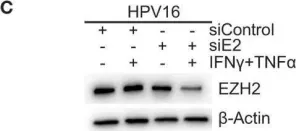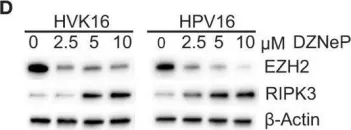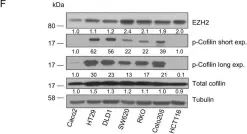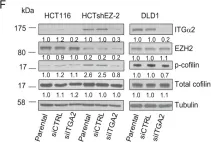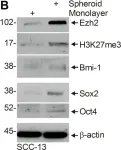Triple-negative breast cancer (TNBC) is the most aggressive breast cancer subtype and has the highest rate of recurrence1. The predominant standard of care for advanced TNBC is systemic chemotherapy with or without immunotherapy; however, responses are typically short lived1,2. Thus, there is an urgent need to develop more effective treatments. Components of the PI3K pathway represent plausible therapeutic targets; more than 70% of TNBCs have alterations in PIK3CA, AKT1 or PTEN3-6. However, in contrast to hormone-receptor-positive tumours, it is still unclear whether or how triple-negative disease will respond to PI3K pathway inhibitors7. Here we describe a promising AKT-inhibitor-based therapeutic combination for TNBC. Specifically, we show that AKT inhibitors synergize with agents that suppress the histone methyltransferase EZH2 and promote robust tumour regression in multiple TNBC models in vivo. AKT and EZH2 inhibitors exert these effects by first cooperatively driving basal-like TNBC cells into a more differentiated, luminal-like state, which cannot be effectively induced by either agent alone. Once TNBCs are differentiated, these agents kill them by hijacking signals that normally drive mammary gland involution. Using a machine learning approach, we developed a classifier that can be used to predict sensitivity. Together, these findings identify a promising therapeutic strategy for this highly aggressive tumour type and illustrate how deregulated epigenetic enzymes can insulate tumours from oncogenic vulnerabilities. These studies also reveal how developmental tissue-specific cell death pathways may be co-opted for therapeutic benefit.
© 2024. The Author(s).
Product Citations: 55
AKT and EZH2 inhibitors kill TNBCs by hijacking mechanisms of involution.
In Nature on 1 November 2024 by Schade, A. E., Perurena, N., et al.
In Nature Communications on 6 August 2024 by Cacciatore, A., Shinde, D., et al.
Castration-resistant prostate cancer (CRPC) is a frequently occurring disease with adverse clinical outcomes and limited therapeutic options. Here, we identify methionine adenosyltransferase 2a (MAT2A) as a critical driver of the androgen-indifferent state in ERG fusion-positive CRPC. MAT2A is upregulated in CRPC and cooperates with ERG in promoting cell plasticity, stemness and tumorigenesis. RNA, ATAC and ChIP-sequencing coupled with histone post-translational modification analysis by mass spectrometry show that MAT2A broadly impacts the transcriptional and epigenetic landscape. MAT2A enhances H3K4me2 at multiple genomic sites, promoting the expression of pro-tumorigenic non-canonical AR target genes. Genetic and pharmacological inhibition of MAT2A reverses the transcriptional and epigenetic remodeling in CRPC models and improves the response to AR and EZH2 inhibitors. These data reveal a role of MAT2A in epigenetic reprogramming and provide a proof of concept for testing MAT2A inhibitors in CRPC patients to improve clinical responses and prevent treatment resistance.
© 2024. The Author(s).
-
WB
-
Cancer Research
-
Endocrinology and Physiology
In Cancer Research on 16 December 2022 by Hong, J., Lee, J. H., et al.
The immunosuppressive tumor microenvironment in some cancer types, such as luminal breast cancer, supports tumor growth and limits therapeutic efficacy. Identifying approaches to induce an immunostimulatory environment could help improve cancer treatment. Here, we demonstrate that inhibition of cancer-intrinsic EZH2 promotes antitumor immunity in estrogen receptor α-positive (ERα+) breast cancer. EZH2 is a component of the polycomb-repressive complex 2 (PRC2) complex, which catalyzes trimethylation of histone H3 at lysine 27 (H3K27me3). A 53-gene PRC2 activity signature was closely associated with the immune responses of ERα+ breast cancer cells. The stimulatory effects of EZH2 inhibition on immune surveillance required specific activation of type I IFN signaling. Integrative analysis of PRC2-repressed genes and genome-wide H3K27me3 landscape revealed that type I IFN ligands are epigenetically silenced by H3K27me3. Notably, the transcription factor STAT2, but not STAT1, mediated the immunostimulatory functions of type I IFN signaling. Following EZH2 inhibition, STAT2 was recruited to the promoters of IFN-stimulated genes even in the absence of the cytokines, suggesting the formation of an autocrine IFN-STAT2 axis. In patients with luminal breast cancer, high levels of EZH2 and low levels of STAT2 were associated with the worst antitumor immune responses. Collectively, this work paves the way for the development of an effective therapeutic strategy that may reverse immunosuppression in cancer.
Inhibition of EZH2 activates a type I IFN-STAT2 signaling axis and provides a therapeutic strategy to stimulate antitumor immunity and therapy responsiveness in immunologically cold luminal breast cancer.
©2022 American Association for Cancer Research.
-
Cancer Research
-
Genetics
-
Immunology and Microbiology
In Cancer Research on 15 December 2021 by Fisher, M. L., Balinth, S., et al.
Bromodomain containing protein 4 (BRD4) plays a critical role in controlling the expression of genes involved in development and cancer. Inactivation of BRD4 inhibits cancer growth, making it a promising anticancer drug target. The cancer stem cell (CSC) population is a key driver of recurrence and metastasis in patients with cancer. Here we show that cancer stem-like cells can be enriched from squamous cell carcinomas (SCC), and that these cells display an aggressive phenotype with enhanced stem cell marker expression, migration, invasion, and tumor growth. BRD4 is highly elevated in this aggressive subpopulation of cells, and its function is critical for these CSC-like properties. Moreover, BRD4 regulates ΔNp63α, a key transcription factor that is essential for epithelial stem cell function that is often overexpressed in cancers. BRD4 regulates an EZH2/STAT3 complex that leads to increased ΔNp63α-mediated transcription. Targeting BRD4 in human SCC reduces ΔNp63α, leading to inhibition of spheroid formation, migration, invasion, and tumor growth. These studies identify a novel BRD4-regulated signaling network in a subpopulation of cancer stem-like cells, elucidating a possible avenue for effective therapeutic intervention. SIGNIFICANCE: This study identifies a signaling cascade driven by BRD4 that upregulates ΔNp63α to promote cancer stem-like properties, which has potential therapeutic implications for the treatment of squamous cell carcinomas.
©2021 American Association for Cancer Research.
-
Biochemistry and Molecular biology
-
Cancer Research
-
Stem Cells and Developmental Biology
Dynamic prostate cancer transcriptome analysis delineates the trajectory to disease progression.
In Nature Communications on 2 December 2021 by Bolis, M., Bossi, D., et al.
Comprehensive genomic studies have delineated key driver mutations linked to disease progression for most cancers. However, corresponding transcriptional changes remain largely elusive because of the bias associated with cross-study analysis. Here, we overcome these hurdles and generate a comprehensive prostate cancer transcriptome atlas that describes the roadmap to tumor progression in a qualitative and quantitative manner. Most cancers follow a uniform trajectory characterized by upregulation of polycomb-repressive-complex-2, G2-M checkpoints, and M2 macrophage polarization. Using patient-derived xenograft models, we functionally validate our observations and add single-cell resolution. Thereby, we show that tumor progression occurs through transcriptional adaption rather than a selection of pre-existing cancer cell clusters. Moreover, we determine at the single-cell level how inhibition of EZH2 - the top upregulated gene along the trajectory - reverts tumor progression and macrophage polarization. Finally, a user-friendly web-resource is provided enabling the investigation of dynamic transcriptional perturbations linked to disease progression.
© 2021. The Author(s).
-
WB
-
Cancer Research
In Oncotarget on 2 October 2018 by Adhikary, G., Grun, D., et al.
Fig.2.C

-
WB
-
Mus musculus (House mouse)
Collected and cropped from Oncotarget by CiteAb, provided under a CC-BY license
Image 1 of 15
In Oncotarget on 2 October 2018 by Adhikary, G., Grun, D., et al.
Fig.4.H

-
WB
-
Mus musculus (House mouse)
Collected and cropped from Oncotarget by CiteAb, provided under a CC-BY license
Image 1 of 15
In Oncotarget on 2 October 2018 by Adhikary, G., Grun, D., et al.
Fig.4.D

-
WB
-
Mus musculus (House mouse)
Collected and cropped from Oncotarget by CiteAb, provided under a CC-BY license
Image 1 of 15
In Front Immunol on 7 December 2016 by Ma, W., Tummers, B., et al.
Fig.4.C

-
WB
-
Collected and cropped from Front Immunol by CiteAb, provided under a CC-BY license
Image 1 of 15
In Front Immunol on 7 December 2016 by Ma, W., Tummers, B., et al.
Fig.4.D

-
WB
-
Collected and cropped from Front Immunol by CiteAb, provided under a CC-BY license
Image 1 of 15
In PLoS One on 31 December 2014 by Ferraro, A., Boni, T., et al.
Fig.1.C

-
WB
-
Homo sapiens (Human)
Collected and cropped from PLoS One by CiteAb, provided under a CC-BY license
Image 1 of 15
In PLoS One on 31 December 2014 by Ferraro, A., Boni, T., et al.
Fig.1.B

-
WB
-
Collected and cropped from PLoS One by CiteAb, provided under a CC-BY license
Image 1 of 15
In PLoS One on 31 December 2014 by Ferraro, A., Boni, T., et al.
Fig.1.F

-
WB
-
Collected and cropped from PLoS One by CiteAb, provided under a CC-BY license
Image 1 of 15
In PLoS One on 31 December 2014 by Ferraro, A., Boni, T., et al.
Fig.2.F

-
WB
-
Collected and cropped from PLoS One by CiteAb, provided under a CC-BY license
Image 1 of 15
In PLoS One on 31 December 2014 by Ferraro, A., Boni, T., et al.
Fig.2.C

-
WB
-
Collected and cropped from PLoS One by CiteAb, provided under a CC-BY license
Image 1 of 15
In PLoS One on 31 December 2014 by Ferraro, A., Boni, T., et al.
Fig.2.E

-
WB
-
Collected and cropped from PLoS One by CiteAb, provided under a CC-BY license
Image 1 of 15
In PLoS One on 31 December 2014 by Ferraro, A., Boni, T., et al.
Fig.2.D

-
WB
-
Collected and cropped from PLoS One by CiteAb, provided under a CC-BY license
Image 1 of 15
In PLoS One on 1 January 2014 by Adhikary, G., Grun, D., et al.
Fig.2.B

-
WB
-
Homo sapiens (Human)
Collected and cropped from PLoS One by CiteAb, provided under a CC-BY license
Image 1 of 15
In PLoS One on 1 January 2014 by Adhikary, G., Grun, D., et al.
Fig.7.C

-
WB
-
Collected and cropped from PLoS One by CiteAb, provided under a CC-BY license
Image 1 of 15
In PLoS One on 19 May 2010 by Kunderfranco, P., Mello-Grand, M., et al.
Fig.3.C,D,E

-
WB
-
Homo sapiens (Human)
Collected and cropped from PLoS One by CiteAb, provided under a CC-BY license
Image 1 of 15



